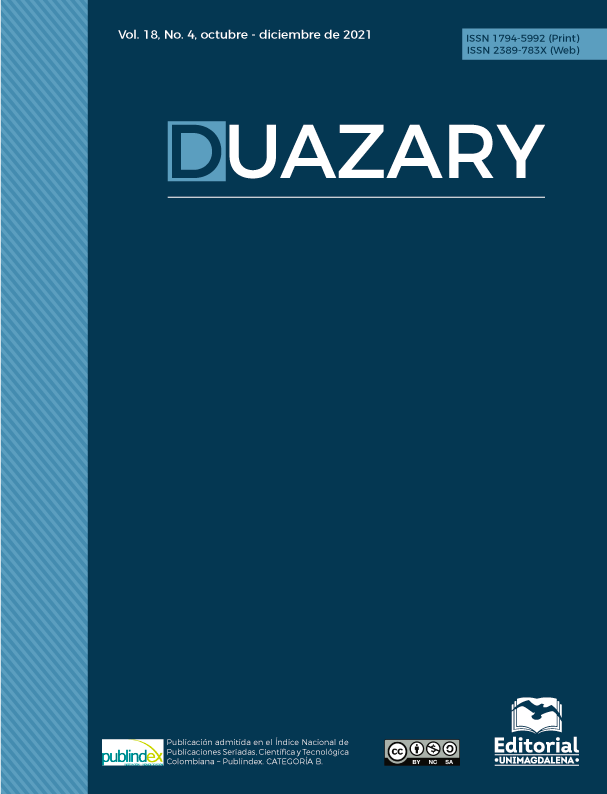Abstract
The STOP-Bang has been promoted as a valuable tool for identifying obstructive sleep apnea-hypopnea syndrome (OSAHS) in medical and surgical patients. However, its performance in Colombian samples is unknown. The objective of this study was to determine the clinimetric performance of the STOP-Bang index versus the study of polysomnography in patients from Santa Marta, Colombia. An accuracy study of diagnostic tests with a test-based approach was designed. Seven hundred sixty-two adults referred for polysomnography to evaluate OSAHS were included in the research. They were aged between 18 and 94 years old (mean=47.2, SD=13.4), 63.3% were men, and 46.5% were classified as obese. The STOP-Bang performance was compared against the best reference criterion, the hypopnea/apnea index determined by polysomnography. The diagnosis of OSAHS was confirmed in 461 (60.5%) and corroborated in 301 (39.5%). The area under the curve was 0.70 (95%CI 0.66-0.74), and the best cut-off point was 4, with a sensitivity of 79.2%, a specificity of 53.5%, the positive predictive value of 72.2%, the negative predictive value of 62.6%, positive likelihood ratio was 1.70, negative likelihood ratio was 0.39; OR=4.08 (CI95% 2.99-5.56) and Cohen's kappa of 0.33. As conclusions, performance indicators show that STOP-Bang...References
Peppard PE, Young T, Barnet JH, Palta M, Hagen EW, Hla KM. Increased prevalence of sleep-disordered breathing in adults. Am J Epidemiol. 2013; 177(9): 1006-14. Doi: https://doi.org/10.1093/aje/kws342
Yaggi HK, Concato J, Kernan WN, Lichtman JH, Brass LM, Mohsenin V. Obstructive sleep apnea as a risk factor for stroke and death. N Engl J Med. 2005; 353(19): 2034-41. Doi: https://doi.org/10.1056/NEJMoa043104
Jennum P, Kjellberg J. Health, social and economic consequences of sleep-disordered breathing: a controlled national study. Thorax. 2011; 66(7): 560-6. Doi: https://doi.org/10.1136/thx.2010.143958
Ramachandran SK, Josephs LA. A meta-analysis of clinical screening tests for obstructive sleep apnea. Anesthesiology. 2009; 110(4): 928-39. Doi: https://doi.org/10.1097/ALN.0b013e31819c47b6
Abrishami A, Khajehdehi A, Chung F. A systematic review of screening questionnaires for obstructive sleep apnea. Can J Anesth. 2010; 57(5): 423-38. Doi: https://doi.org/10.1007/s12630-010-9280-x
Chiu HY, Chen PY, Chuang LP, Chen NH, Tu YK, Hsieh YJ, et al. Diagnostic accuracy of the Berlin questionnaire, STOP-BANG, STOP, and Epworth sleepiness scale in detecting obstructive sleep apnea: a bivariate meta-analysis. Sleep Med Rev. 2017; 36: 57-70. Doi: https://doi.org/10.1016/j.smrv.2016.10.004
Chung F, Yegneswaran B, Liao P, Chung SA, Vairavanathan S, Islam S, et al. STOP questionnaire: A tool to screen patients for obstructive sleep apnea. Anesthesiology. 2008; 108(5): 812-21. Doi: https://doi.org/10.1097/ALN.0b013e31816d83e4
Adult Obstructive Sleep Apnea Task Force of the American Academy of Sleep Medicine. Clinical guideline for the evaluation, management, and long-term care of obstructive sleep apnea in adults. J Clin Sleep Med. 2009; 5(3): 263-76. Doi: https://doi.org/10.5664/jcsm.27497
Yang Y, Chung F. A screening tool of obstructive sleep apnea: STOP-Bang questionnaire. Sleep Med Clin. 2013; 8(1): 65-72. Doi: https://doi.org/10.1016/j.jsmc.2012.11.004
Brenner H, Gefeller O. Variation of sensitivity, specificity, likelihood ratios and predictive values with disease prevalence. Stat Med. 1997; 16(9): 981-91. Doi: https://doi.org/10.1002/(SICI)1097-0258(19970515)16:9<981::AID-SIM510>3.0.CO;2-N
Viera AJ, Garrett JM. Understanding interobserver agreement: the kappa statistic. Fam Med. 2005; 37(5): 360-3. Available at: http://www1.cs.columbia.edu/~julia/courses/CS6998/Interrater_agreement.Kappa_statistic.pdf
Ruiz AJ, Rendon MA, Hidalgo P, Cañón M, Otero L, Panqueva OP, et al. Prevalence of sleep complaints in Colombia at different altitudes. Sleep Sci. 2016; 9(2): 100-5. Doi: https://doi.org/ 10.1016/j.slsci.2016.05.008
Goodridge D, Marciniuk D. Rural and remote care: overcoming the challenges of distance. Chron Respir Dis. 2016; 13(2): 192-203. Doi: https://doi.org/10.1177/1479972316633414
Acar HV, Yarkan Uysal H, Kaya A, Ceyhan A, Dikmen B. Does the STOP-Bang, an obstructive sleep apnea screening tool, predict difficult intubation? Eur Rev Med Pharmacol Sci. 2014; 18(13): 1869-74. Available: https://www.europeanreview.org/article/7555
Cohen J. A coefficient of agreement for nominal scales. Educ Psychol Meas. 1960; 20(1): 37-46. Doi: https://doi.org/10.1177/001316446002000104
Hajian-Tilaki K. Receiver operating characteristic (ROC) curve analysis for medical diagnostic test evaluation. Caspian J Intern Med. 2013; 4(2): 627-35. Available at: http://caspjim.com/article-1-193.html
Cowan DC, Allardice G, MacFarlane D, Ramsay D, Ambler H, Banham S, et al. Predicting sleep disordered breathing in outpatients with suspected OSA. BMJ Open. 2014; 4(4): e004519. Doi: https://doi.org/10.1136/bmjopen-2013-004519
Chung F, Abdullah HR, Liao P. STOP-Bang questionnaire: a practical approach to screen for obstructive sleep apnea. Chest. 2016; 149(3): 631-8. Doi: https://doi.org/10.1378/chest.15-0903
Prasad KT, Sehgal IS, Agarwal R, Aggarwal AN, Behera D, Dhooria S. Assessing the likelihood of obstructive sleep apnea: a comparison of nine screening questionnaires. Sleep Breath. 2017; 21(4): 909-17. Doi: https://doi.org/10.1007/s11325-017-1495-4
Nagappa M, Liao P, Wong J, Auckley D, Ramachandran SK, Memtsoudis S, et al. Validation of the STOP-Bang questionnaire as a screening tool for obstructive sleep apnea among different populations: a systematic review and meta-analysis. PloS One. 2015; 10 (12): e0143697. Doi: https://doi.org/10.1371/journal.pone.0143697
Greiner M, Gardner IA. Epidemiologic issues in the validation of veterinary diagnostic tests. Prev Vet Med. 2000; 45(1-2): 3-22. Doi: https://doi.org/10.1016/S0167-5877(00)00114-8
Campo-Arias A, Herazo E. [Intra- and inter-rater concordance]. Rev Colomb Psiquiatr. 2010; 39(2):424-32. Doi: https://doi.org/10.1016/S0034-7450(14)60261-4

This work is licensed under a Creative Commons Attribution-NonCommercial-ShareAlike 4.0 International License.
Copyright (c) 2021 Universidad del Magdalena

